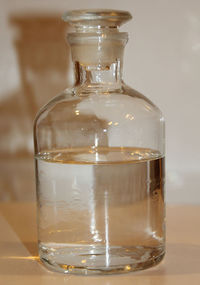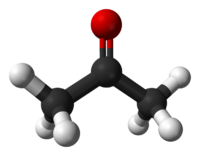Acetone
 Sample of acetone
| |
 Acetone chemical structure
| |
| Names | |
|---|---|
| IUPAC name
Propanone
| |
| Preferred IUPAC name
Propan-2-one | |
| Other names
2-Propanone
Dimethyl carbonyl Dimethyl formaldehyde Dimethylketal Dimethyl ketone Ketone propane Pyroacetic spirit Spirit of Saturn β-Ketopropane | |
| Properties | |
| C3H6O (CH3)2CO | |
| Molar mass | 58.08 g/mol |
| Appearance | Colorless volatile liquid |
| Odor | Pungent, irritating, floral |
| Density | 0.7845 g/cm3 (25 °C) |
| Melting point | −94.7 °C (−138.5 °F; 178.5 K) |
| Boiling point | 56.05 °C (132.89 °F; 329.20 K) |
| Miscible | |
| Solubility | Miscible with almost all organic solvents Immiscible with perfluorocarbons |
| Vapor pressure | 9.39 kPa (0 °C) 30.6 kPa (25 °C) 374 kPa (100 °C) 2.8 MPa (200 °C) |
| Acidity (pKa) | 19.2 |
| Thermochemistry | |
| Std molar
entropy (S |
200.4 J·mol-1·K-1 |
| Std enthalpy of
formation (ΔfH |
−250.03 - −248.77 kJ/mol |
| Hazards | |
| Safety data sheet | Sigma-Aldrich |
| Flash point | −20 °C (−4 °F; 253 K) |
| Lethal dose or concentration (LD, LC): | |
| LD50 (Median dose)
|
5,800 mg/kg (rat, oral) 3,000 mg/kg (mouse, oral) 5,340 mg/kg (rabbit, oral) |
| LC50 (Median concentration)
|
20,702 ppm (rat, 8 hr) |
| Related compounds | |
| Related compounds
|
Methyl ethyl ketone |
| Except where otherwise noted, data are given for materials in their standard state (at 25 °C [77 °F], 100 kPa). | |
| Infobox references | |
Acetone, also known as propanone or dimethyl ketone (chemical formula (CH3)2CO) is a popular solvent and useful chemical for lots of organic chemistry, being the simplest ketone.
Contents
Properties
Chemical
Acetone is highly flammable and will burn in air releasing carbon dioxide and water vapors.
It will react with halogens to form halogenated organic compounds, i.e. chloroacetone, bromoacetone, iodoacetone. Acetone reacts very exothermically with halogens dissolved in basic solutions to give a haloform of the said halogen, process known as haloform reaction. One example is with household bleach and other hypochlorites to form chloroform.
Acetone will form the unpredictable and dangerous explosive acetone peroxide when oxidized with hydrogen peroxide under certain conditions, such as with an acid catalyst.
Physical
Acetone is a clear liquid with very low viscosity that is miscible in water, that boils at 56°C and freezes between −95 to −93 °C. It has a sharp, somewhat sweet, and floral aroma similar to other ketones. It is also miscible in benzene, chloroform, ethanol, diethyl ether and methanol.
Availability
Acetone can be found at hardware stores as paint thinners or nail polish remover, either pure or mixed with other organic substances (usually esters). Distillation may be required to purify the acetone.
Most technical-grade acetone tends to be fairly pure and has very little if any water. If you want it more pure, you can distill it again.
Preparation
Industrially, acetone is made via the cumene process, where benzene is alkylated with propylene to produce cumene, which is oxidized by air to produce phenol and acetone.
Before that method, acetone was produced via dry distillation of an acetate salt, usually calcium acetate or sodium acetate.
- 2 Na(CH3COO) → Na2CO3 + (CH3)2CO
- Ca(CH3COO)2 → CaCO3 + (CH3)2CO
Because this reaction occurs at around 400-500°C, temperature above the boiling and autoignition temperature of acetone, it must be performed in an oxygen free chamber (carbon dioxide rich or only atmosphere is sufficient) and because the acetone results as vapors, it must be condensed.
Acetone can be recovered from an aqueous solution by salting out with anhydrous sodium acetate, which is conveniently produced from vinegar and baking soda.
Projects
- Methyl methacrylate synthesis
- Acetone peroxide synthesis
- Chloroform synthesis
- Organic extractions
- Make ethenone
Handling
Safety
Skin contact with acetone is not recommended, as prolonged exposure can cause defatting of the skin. Acetone's low boiling point of requires work in a ventilated area. While acetone is volatile and while its fumes are not particularly toxic, they can be irritating in large amounts. Acetone however is among the least toxic solvents, and as many studies have shown there are no long term risks in case of repeated exposure.
The main danger of acetone comes from its flammability. Its vapors have a flash point much below room temperature, so air/acetone mixtures can explode or burst into flames easily, even from static shocks.
At temperatures above 486 °C, acetone will self-ignite.
Storage
Acetone is best stored in closed bottles, away from any source of heat.
Disposal
Acetone can be safely burned. Traces of acetone can be released in open air. Strongly diluted acetone solutions can be poured down the drain, but do not release large amounts.
NEVER discard acetone along with hydrogen peroxide as it will form acetone peroxide, which is a sensible contact explosive.